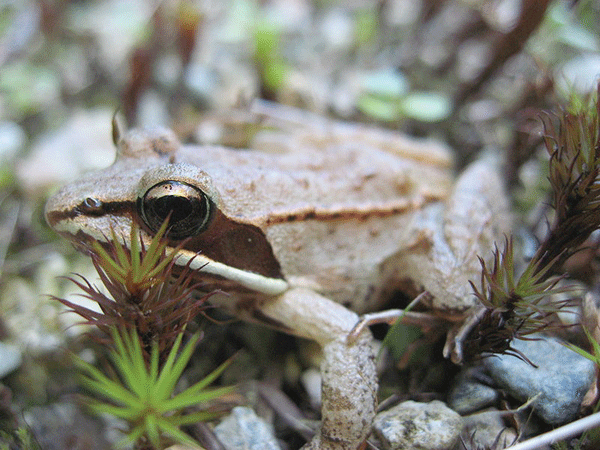Hot and Cold for Spring

During the fickle days of early spring, my emotions seem to rise and fall in sync with sap in the maple trees. I get kind of grumpy when the mornings dawn damp and cool and the tracks on the ski trails sink dejectedly into the slush. After the extended ski seasons of the past two years, I’ve gotten accustomed to having endless days to explore new trails and perfect technique.
My feelings change as the days brighten, intense sun takes over, and the temperature spikes. Warm breezes and dry roads make me eager to put away the skis, and happy to pull my road bike out of storage. I guess you could say that I’m running hot and cold for spring.
The first place I head on my inaugural spring bike ride is to a little wetland across the county road from Lake Namakagon. This wetland tends to thaw a bit sooner than the one by my house and it is consistently the first place I hear the spring chorus of frogs.
The eleven species of Wisconsin frogs (and one species of toad) wake up and begin singing their songs in a typical order each spring. Their specific phenological timelines depend on things like overwintering location, cold tolerance, and breeding habitat.
Our three earliest singers share some common characteristics. Wood frogs, chorus frogs, and spring peepers are all somewhat terrestrial frogs that spend the winter as frogcicles, buried lightly in duff on the forest floor. Spring sun and warm rains can reach them quickly here, and they are triggered to thaw, wake up next door to their honeymoon suites, and breed very early in the season. April is typically their main month of romance, but each spring progresses a little differently.
By getting such an early start, these frogs are able to carry out their entire breeding cycle in vernal pools. These woodland puddles only persist for a few months each spring. This means that eggs and tadpoles don’t have to worry about the fishy predators who would live in a permanent body of water, but it also means that the parents need to hurry up and get their babies growing so that they can gain legs before the pool dries up.
Of course, spending winter on land has its own challenges. Even though the subnivean layer—where snow meets earth—remains warmer than the television weather report, frogs in the duff must still endure below-freezing temperature for many days at a time. They do this not by avoiding the frogcicle state, but by guiding it.
Wood frogs are the most highly studied, but spring peepers and chorus frogs use similar techniques. The process starts early in fall, when wood frogs begin accumulating urea in their tissues. While urea is a waste product that humans excrete in our urine, urea is also a cryoprotectant, or a substance used to protect biological tissue from freezing damage.
Then, when the temperatures dip below 32 degrees Fahrenheit, ice crystals start to form on the frog’s skin. Some animals are able to “supercool” or prevent the formation of ice even when temps dip below freezing. This usually requires them to avoid contact with ice that would trigger flash freezing. Frogs, with their permeable skin, just allow the frost to set events in motion.
Ice formation causes the frog’s liver to convert stored glycogen into glucose. The sugar floods throughout the frog’s body, carried in its bloodstream by a heart that keeps beating as long as possible. As ice forms outside of cells, it locks up the pure water, and leaves behind a higher concentration of salts and other things that were previously dissolved in the liquid. Water from inside the cells wants to flow outward, across the cell membrane, to even out the imbalanced concentrations.
This could dangerously dehydrate the cells, though, and there is a threat of them collapsing. Glucose and urea help the cells retain water in two ways. First, sugar water freezes as a lower temperature than plain water, and so less ice forms overall. Second, by increasing the concentration of chemicals inside the cell, it keeps water from wanting to flow out of the cell under osmotic pressure.
While frozen, the frogs are essentially dead.
Once spring comes, however, wood frogs thaw from the inside out. The heart starts beating (scientists still don’t know what jumpstarts it), the brain wakes up, and finally legs move. And those legs will carry them directly to a nearby vernal pool. A deafening chorus of love songs ensues, and mating commences in a hurry. Wood frogs quack, spring peepers jingle like bells, and chorus frogs imitate a finger plinking a plastic comb.
That’s what I was hoping for today, but the wetland was still quietly blanketed in snow. Over the winter, the frogs may undergo multiple freeze-thaw cycles. Springtime warmth also ebbs and flows. And then there’s me, sometimes turning a chilly shoulder to our next season, and sometimes embracing it with an open sweater. I guess I’m not the only who runs hots and cold!
For over 45 years, the Cable Natural History Museum has served to connect you to the Northwoods. Come visit us in Cable, WI! Our new phenology exhibit: “Nature’s Calendar: Signs of the Seasons” will open May 1, 2016.
Find us on the web at www.cablemuseum.org to learn more about our exhibits and programs. Discover us on Facebook, or at our blogspot, http://cablemuseumnaturalconnections.blogspot.com.
